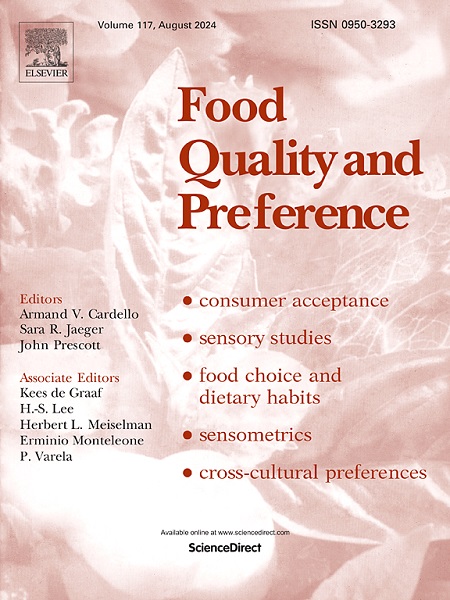As good as fresh nutritionally but not perceived that way: Implicit and explicit biases towards canned and frozen fruits and vegetables
IF 4.9
1区 农林科学
Q1 FOOD SCIENCE & TECHNOLOGY
引用次数: 0
Abstract
Globally, fruit and vegetable (F&V) consumption is lower than recommended, with inadequate consumption linked to many non-communicable diseases. Inadequate F&V consumption can, in part, result from the cost and access barriers to fresh F&V that are present in certain parts of the world. While use of canned and frozen F&Vs may provide a solution, their consumption/acceptability tends to be lower than fresh F&V. This study explored the explicit and implicit biases that may exist towards canned and frozen F&V in comparison to fresh equivalents. In Study 1, participants were administered self-report scales that measured their beliefs towards canned, frozen and fresh F&V across health, convenience, and appeal, including the impact of Australia's health star rating system. In Study 2, Implicit Association Tests were administered for canned and frozen F&V, versus fresh. In Study 1, explicit ratings confirmed a strong preference for fresh F&V, particularly regarding health, even when participants were informed about the equivalent health star ratings. The study also highlighted a convenience advantage for canned and frozen foods, although these benefits did not outweigh the bias towards fresh produce. In Study 2, an implicit bias against canned and frozen F&V was evident, with significantly slower categorization times for positive associations, compared to fresh F&V. These findings indicate the existence of an attitudinal bias against frozen and canned F&V. To increase intake of F&V, especially when fresh F&V is not accessible/affordable, future research needs to understand how to target the identified biases that limit consumption of canned and frozen alternatives.
营养上和新鲜一样好,但人们并不这么认为:对罐装和冷冻水果和蔬菜的隐性和显性偏见
在全球范围内,水果和蔬菜的消费量低于建议水平,消费不足与许多非传染性疾病有关。在某种程度上,食品消费不足可能是由于在世界某些地区存在新鲜食品的成本和获取障碍造成的。虽然使用罐装和冷冻食品可能提供一种解决方案,但它们的消费量/接受度往往低于新鲜食品。本研究探讨了与新鲜食品相比,对罐装和冷冻食品可能存在的显性和隐性偏见。在研究1中,参与者接受了自我报告量表,以衡量他们对罐装、冷冻和新鲜食品的健康、便利和吸引力的看法,包括澳大利亚健康星级评级系统的影响。在研究2中,对罐装和冷冻食品进行内隐联想测试,而不是新鲜食品。在研究1中,明确的评级证实了人们对新鲜食品的强烈偏好,尤其是在健康方面,即使参与者被告知同等的健康星级评级。该研究还强调了罐装和冷冻食品的便利优势,尽管这些好处并没有超过对新鲜农产品的偏好。在研究2中,对罐装食品和冷冻食品的内隐偏见是明显的,与新鲜食品相比,对积极关联的分类时间明显较慢。这些发现表明存在对冷冻食品和罐装食品的态度偏见。为了增加食品和蔬菜的摄入量,特别是在新鲜食品和蔬菜难以获得/负担得起的情况下,未来的研究需要了解如何针对已确定的限制罐装和冷冻替代品消费的偏见。
本文章由计算机程序翻译,如有差异,请以英文原文为准。
求助全文
约1分钟内获得全文
求助全文
来源期刊

Food Quality and Preference
工程技术-食品科技
CiteScore
10.40
自引率
15.10%
发文量
263
审稿时长
38 days
期刊介绍:
Food Quality and Preference is a journal devoted to sensory, consumer and behavioural research in food and non-food products. It publishes original research, critical reviews, and short communications in sensory and consumer science, and sensometrics. In addition, the journal publishes special invited issues on important timely topics and from relevant conferences. These are aimed at bridging the gap between research and application, bringing together authors and readers in consumer and market research, sensory science, sensometrics and sensory evaluation, nutrition and food choice, as well as food research, product development and sensory quality assurance. Submissions to Food Quality and Preference are limited to papers that include some form of human measurement; papers that are limited to physical/chemical measures or the routine application of sensory, consumer or econometric analysis will not be considered unless they specifically make a novel scientific contribution in line with the journal''s coverage as outlined below.
 求助内容:
求助内容: 应助结果提醒方式:
应助结果提醒方式:


